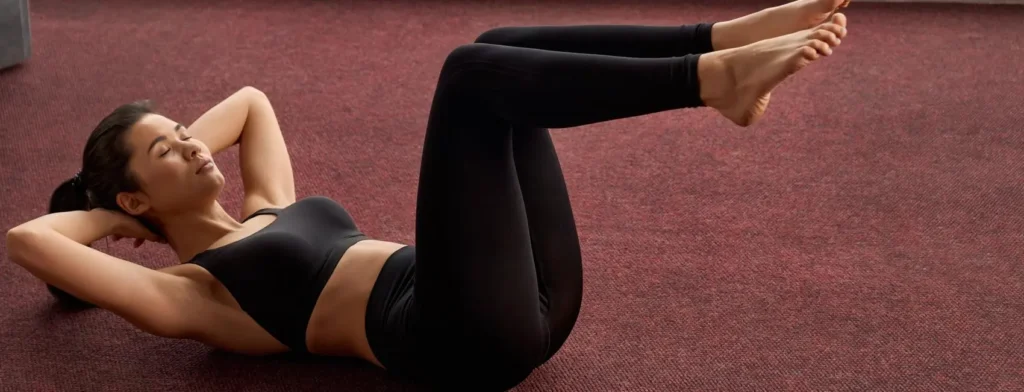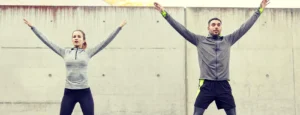Reverse crunches are an effective abdominal exercise that targets the lower abs and helps strengthen the core. Unlike traditional crunches that focus on the upper portion of the abdominals, reverse crunches primarily engage the rectus abdominis and the transverse abdominis.
During a reverse crunch, you lie on your back with your knees bent and feet flat on the floor. By lifting your hips off the ground and curling your knees towards your chest, you create a contraction in the lower abs. This movement activates the rectus abdominis, which is responsible for flexing the spine, and the transverse abdominis, which provides stability and support to the core.
Additionally, reverse crunches engage the hip flexors, the muscles located in the front of the hips. These muscles assist in lifting the hips off the ground and contribute to the overall movement.
The rectus abdominis, transverse abdominis, and hip flexors work together to perform the reverse crunch, helping to improve core strength and stability. By strengthening these muscles, reverse crunches can enhance posture, support the spine, and contribute to better overall functional movement.
One benefit of reverse crunches is that they target the lower abs, an area that can be challenging to engage with traditional abdominal exercises. By specifically targeting the lower abs, reverse crunches help to tone and strengthen the muscles in this region, contributing to a more defined and sculpted midsection.
In addition to the abdominal muscles, reverse crunches also involve the engagement of other stabilizing muscles, including the erector spinae (lower back muscles) and the hip extensors. These muscles work to support and stabilize the spine and hips during the movement, promoting a balanced and integrated core workout.
Reverse crunches can be an effective exercise for individuals of various fitness levels. They can be modified to suit different abilities by adjusting the range of motion or incorporating variations such as leg raises or adding resistance through ankle weights or a stability ball.
Reverse Crunches – Instructions & Steps
- Start with your back on the ground and your arms out with palms on the ground for stability
- Bring your knees up so they are in line with your hips
- Slowly use your core to bring your knees towards your chest. Do not raise your back off the ground to meet them. Let your core do the work.
- Repeat
Benefits of Reverse Crunches
Reverse crunches offer several benefits for the body and can be a valuable addition to an abdominal workout routine. When performing reverse crunches, it is crucial to maintain proper form, avoid excessive strain on the neck or lower back, and listen to your body. Start with a comfortable range of motion and gradually increase the difficulty as your strength improves. Here are some of the benefits of reverse crunches
Targeted Lower Abdominal Engagement
Reverse crunches primarily target the lower abdominal muscles, specifically the lower portion of the rectus abdominis. By focusing on this area, reverse crunches help to tone and strengthen the lower abs, contributing to a more defined and sculpted midsection.
Core Strength and Stability
Reverse crunches engage not only the lower abs but also the entire core, including the rectus abdominis, transverse abdominis, and other stabilizing muscles. This exercise helps to strengthen the core muscles, promoting better posture, spinal alignment, and overall stability.
Improved Hip Flexor Strength
The hip flexors, located in the front of the hips, play a significant role in performing reverse crunches. By repeatedly contracting and engaging the hip flexors during the exercise, you can strengthen these muscles, enhancing hip mobility, and supporting better overall movement patterns.
Reduced Lower Back Discomfort
Strengthening the core, including the lower abs, can provide support to the lower back and help alleviate discomfort or pain. Reverse crunches contribute to core stability, which can improve spinal alignment and reduce the strain on the lower back.
Enhanced Functional Movement
Having a strong core is essential for performing daily activities and other exercises effectively. Reverse crunches help to improve core strength and stability, enhancing your ability to perform movements such as lifting, bending, twisting, and maintaining balance.
Versatile and Accessible Exercise
Reverse crunches can be easily modified to suit different fitness levels and can be performed with minimal or no equipment. They can be incorporated into various workout routines, including home workouts, gym sessions, or as a part of a targeted abdominal workout.
More About Reverse Crunches
Reverse crunches are not considered a compound exercise. They are an isolation exercise that primarily targets the lower abdominal muscles. Reverse crunches are typically performed lying on your back with your legs lifted towards your chest.
During reverse crunches, the following muscle group is the main focus:
- Lower abdominal muscles: The main muscle group targeted is the rectus abdominis, which runs along the front of the abdomen and helps in flexing the spine.
Reverse crunches can be effective in strengthening the lower abdominal muscles and improving core stability. However, since they involve movement at only one joint and primarily engage one muscle group, they are not considered a compound exercise.
To target multiple muscle groups simultaneously and engage in compound movements, exercises like squats, deadlifts, lunges, and push-ups are more appropriate choices.




